 Metatheria: Asiatherium, marsupials.
Metatheria: Asiatherium, marsupials.| Metatheria | ||
| The Vertebrates | Metatheria |
| Vertebrates Home | Vertebrate | Vertebrate |
Abbreviated Dendrogram
Mammalia
│
├─Eutheria
└─Metatheria
├─Ameridelphia
│ ├─Didelphimorphia
│ └─Paucituberculata
└─Australidelphia
├─Microbiotheria
└─┬─┬─Dasyuromorphia
│ └─Notoryctemorphia
└─┬─Peramelina
└─Diprotodontia |
Contents
|
 Metatheria: Asiatherium, marsupials.
Metatheria: Asiatherium, marsupials.
Fr mK.
Theria: Eutheria + *: Ameridelphia + Australidelphia.
Angular process of dentary inflected; effectively monophyodont (most primary teeth are resorbed without erupting); maximum dental formula 5/4, 1/1, 3/3, 4/4; upper molars with broad cingulum and stylar cusps; hypo- and entoconulids closely spaced; large vacuities in palate; nasals with triangular lateral process at articulation with frontals; auditory bulla, if present, formed by alisphenoid; brain relatively small, with cerebral hemispheres joined by enlarged anterior commisure; anastamosing capillary network over brain absent; epipubic ("marsupial" bones present; chorioallantoic membrane transient or absent; vestigial, transient egg shell may be present; no corpus luteum (young ejected at end of estrus cycle); usually marsupium ("pouch") for immature young; cursorial forms and large carnivores relatively rare.
Links:Animal Diversity Web: Metatheria; Marsupial Mammals; Lecture 05 - Mars. Class./Biog.; Beuteltiere (German); Untitled Document; Mammals - Class Mammalia - All Kinds of Mammals!; Marsupials; Mammals - Infraclass Metatheria; xrefer - Metatheria; MESOZOIC MAMMALS; Deltatheroida, Asiadelphia and 'basal' Metatheria, an internet directory; ANIMAL PLANET - VERTEBRATES(Slovak). APW020616.
Range: From the Late Cretaceous.
Phylogeny: Metatheria: Australidelphia + *: Didelphimorphia + Paucituberculata.
South American, apparently more basal, marsupials; based on molecular data; rostrum long; sagittal crest present; dental formula 5/5, 1/1, 3/3, 4/4; spermatozoa paired in epididimus.
Links: Animal Diversity Web: Paucituberculata; MarsRad.GIF; A New Marsupial from the Early Eocene Tingamarra Local Fauna of ....; THE GEOLOGICALLY OLDEST DASYURID, FROM THE MIOCENE OF RIVERSLEIGH ...; THE SKULL OF EKALTADETA IMA (MARSUPIALIA, HYPSIPRYMNODONTIDAE-)- ...; Animal Diversity Web: Metatheria; Lecture 07 Marsup. Class.; Evolutionary Biology - Phylogeny of Marsupials based on ...; A New Marsupial from the Early Eocene Tingamarra Local Fauna of ... finds insufficient evidence to decide if ameridelphians were present in Australia); .
Note: Quite likely to be paraphyletic parent of Australidelphia. ATW030207.
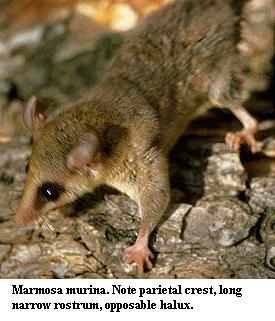 Didelphimorphia: Didelphis and other opossums.
Didelphimorphia: Didelphis and other opossums.
from the Late Cretaceous of North & South America
Ameridelphia: Paucituberculata + *.
Small to medium-sized semi-arboreal, mostly omnivores with some exceptions. Long rostrum; narrow braincase and prominent saggital crest; primitive dental formula 5/4, 1/1, 3/3, 4/4; incisors small; canines large; molars tricuspid; jugal contacts glenoid fossa; plantigrade feet; hind feet have opposable digit 1 with nail, not claw; tail prehensile in living species; stomach simple, with small cecum; marsupium simple fold or absent; usually opportunistic omnivores; range still expanding in NAm.; very plesiomorphic and little changed since K; solitary; females larger.
Links: Brain Collections: MARSUPIALS; Virginiana Opossum (Didelphis virginiana); The Opossum; Lecture 07 Marsup. Class.; Virginia Opossum Printout- EnchantedLearning.com; Some Mammals of the World; Nebraska Wildlife - The Opossums; opossum.htm; Order Didelphimorphia; marsupialia.html; SWISS-PROT taxonomic query: Didelphimorphia; Opossums - Order Didelphimorphia; http://www.apus.ru/on_site.php?p1=810&p3=0 Russian); Didelphimorphia - Vacice (Czech, see also images here); Didelphimorphia Spanish); Zarigüeyas; Didelfidi Italian. basic, but well done -- Best on the Web); Paleocene mammals of the world; Alex Badyaev - Lab Scans for BIOL 306; MESOZOIC MAMMALS; 'basal' Didelphidae & Co, an internet directory; Opossums; Didelphimorphia - Wikipedia. ATW030503.
Paucituberculata: Caenolestes, Lestoros (rat opossums).
Fr upOc of SAm, fl lwMc.
Ameridelphia: Didelphimorphia + *.
Small, terrestrial rodent-like. Elongate, rounded skull (supraoccipital without distinct lambdoid crest results in globular braincase); pointed rostrum; small eyes; dental formula: 3-4/2-4, 1/1, 3/3, 4/4; $ 1-2 lower incisors large & procumbent; 1st premolar with 1 cusp; 1st molar enlarged and blade-like; most molars have hypocone; $ flap of skin on upper lip; large olfactory bulbs; cerebral fissures absent (primitive brain); $ atlas with mobile cervical rib; tail long, with hair, not prehensile; humerus large & heavy; 3-chambered stomach with short intestine; no marsupium; insectivores & omnivores; unique, 4-limbed jumping style.
Links: Lecture 07 Marsup. Class.; pal1 (list of some extinct species); Rat or Shrew Opossums - Order Paucituberculata. 001209.
fr lwPc of SAm, Ant(?). & Aus.
Metatheria: Ameridelphia + *: Microbiotheria + ((Dasyuromorphia + Notoryctemorphia) + (Peramelina + Diprotodontia)).
Australian radiation of metatherians. Based largely on molecular data, tarsal specializations (?).
Image: from Wikipedia
Links: Animal Diversity Web: Metatheria; Australidelphia Mikko's phylogeny); Marsupial - Wikipedia; A New Marsupial from the Early Eocene Tingamarra Local Fauna of ... questioning monophyly); Evolutionary Biology - Phylogeny of Marsupials based on ... more molecular monophyly); A Molecular and Evolutionary Study of the Gene Family of the ...; Fauna of Australia Volume 1b - Mammalia. ATW031211
 Microbiotheria: Dromiciops, Microbiotherium, Khasia?
Microbiotheria: Dromiciops, Microbiotherium, Khasia?
fr lwPc of SAm. & Ant(?).
Australidelphia: (Dasyuromorpha + Notoryctemorphia) + (Peramelina + Diprotodontia)) + *.
Very small (25g), mouse-like form. One living species (Dromiciops) in montane bamboo forests of Chile. Dental formula 5/4, 1/1, 3/3, 4/4; incisors relatively large and spatulate; lower incisors somewhat procumbent; cheek teeth with low, rounded cusps; premaxilla elongated; nasals expanded posteriorly; paroccipital processes absent; auditory bullae greatly enlarged, with ($) entotympanic bone which forms posterior 2/3ds of bulla (in fact, entire posterior portion of skull appears "inflated"); marsupium present, with anteroventral opening; tail long & "moderately prehensile"; may store fat at base of tail; insectivorous (grubs) and/or herbivorous; scansorial; may hibernate; builds nests; no social group beyond mother and young, breeding pairs in season.
Links: ORDER; CHUMAIHUÉN; Marsupiales; La classification des marsupiaux corrigée par la biologie moléculaire; seponetr.html; Entrez-PubMed; Entrez-PubMed.
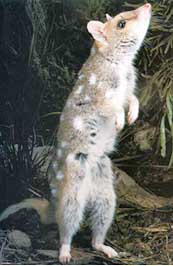 Dasyuromorphia: carnivorous forms, including Dasyurus, Thylacinus (marsupial wolf), Sarcophilius (Tasmanian Devil) & Myrmecobius.
Dasyuromorphia: carnivorous forms, including Dasyurus, Thylacinus (marsupial wolf), Sarcophilius (Tasmanian Devil) & Myrmecobius.
fr upOc.
Australidelphia::: Notoryctemorphia + *.
Dental formula 4/3,1/1, 2-3/2-3, 4/4; incisors small or blade-like; carnassials?; some (Thylacine) with digitigrade posture and cursorial habit, strikingly parallel to placental wolves; no syndactyly; marsupium absent or poorly developed.
Links: Animal Diversity Web: Order Dasyuromorphia; Dasyurs - Order Dasyuromorphia; Some Mammals of the World; Metatheria; Discussion; The Thylacine Museum - Introduction.
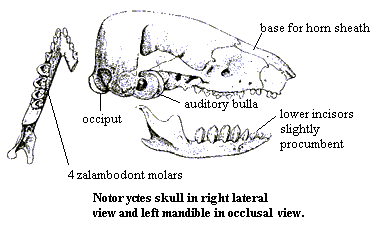 Notoryctemorphia: Notoryctes (marsupial mole).
Notoryctemorphia: Notoryctes (marsupial mole).
fr R of Aus.
Australidelphia::: Dasyuromorphia + *.
2 living species (10-20 cm) with no fossil record. Dental formula: 3-4/3, 1/1, 2/3, 4/4 (varies?); all but last premolar unicuspid; with paracone & metacone fused; molars zalambodont, with talonids absent; eyes reduced, vestigial & without lens; cornified plate on rostrum; auditory pinnae absent; 5 posterior cervical vertebrae fused; short (1-3 cm) leathery tail with distinct rings; manus 2-4 coordinate as spade, 1 & 5 reduced; pes 1 has nail, 2-4 long claw, 5 vestigial; silky fur (as placental moles-- presumably for same function: no nap to permit quicker reversals in tight spaces); highly specialized for fossorial habit in desert soils; may "swim" through soil without permanent burrow; females may have deep nests (?); frequently feeds above ground; marsupium opens posteriorly, divided into 2; insectivore; solitary.
Links: Journal of Molecular Evolution; Animal Diversity Web: Notoryctemorphia; The Marsupials of Australia; Lecture 0X-Cont. Drift; Marsupial Mole - Order Notoryctemorphia (image of live mole).
Image and Note: Notoryctes modified from Starck, D (1995), Wirbeltiere. Teil 5/2: Säugetiere, Verlag: (2 vols.) 1241 pp. (not personally reviewed). Note structure of occiput is reminiscent of microbiothere. This skull also sets off an interesting chain of speculation that the suite of features that distinguishes mammal from non-mammal may be related to fossorial adaptations.
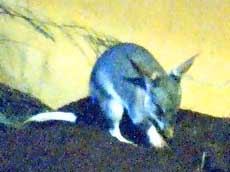 Peramelina: Macrotis bilbey), Chaerops (bandicoots).
Peramelina: Macrotis bilbey), Chaerops (bandicoots).
fr upOc (Mc?) of Aus.
Australidelphia::: Diprotodontia + *.
Dental formula 4-5/3, 1/1, 3/3, 4/4; incisors small; dilambdodont molars; long, narrow rostrum; skull table flattened; typically very long "ears" (pinnae); elongated feet; syndactyly of pes 2&3 (grooming adaptation?); pes 4 largest; halux vestigial or absent; digitigrade; some forms with extreme cursorial adpatations; also some with chorioallantoic membrane; insectivorous.
Links: Australian Bilby Appreciation Society - Main Page; SchoolWorld Endangered Species Project: Rufous Spiny Bandicoot.
Note: may be basal australidelphids, with syndactyly convergent on diprotodonts.
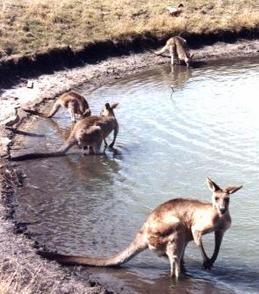 Diprotodontia: kangaroos, potoos, wombats, koalas, etc.
Diprotodontia: kangaroos, potoos, wombats, koalas, etc.
fr upOc of Aus.
Australidelphia::: Peramelina + *.
Herbivorous & omniverous forms plus Thylacoleo. Jaw shortened; diprotodont (not surprisingly) = large pair of procumbent incisors on lower jaw; 3 pairs of upper incisors; no lower canines; heavy tail common; elongated hind limbs; frequent syndactyly (second and third digits on the feet fused up to the base of the claws, with the claws not being fused); hallux absent; males do not show evidence of mammary glands; jumping locomotion very common; mostly herbivorous, with some insectivores (plus Thylacoleo).
Links: Journal of Molecular Evolution; Frames; Animal Diversity Web: Diprotodontia; Some Mammals of the World; Diprotodonts - Order Diprotodontia; Diprotodontia Dvojitozubci (Czech); Lecture 0X-Cont. Drift (I love this site: no pretty pictures, no cute captions, but lots of information); Diprotodonti Italian); Phylogeny of Marsupials based on phosphoglycerate kinase DNA sequences; Systematic Biology 47(3) Abstracts; Noneutherian Mammals; Diprotodontia; Encyclopedia Krygosvet (Russian); subordo Diprotodontia; Diprotodontia Spanish); club.telepolis.com. ATW021019.
checked ATW051023